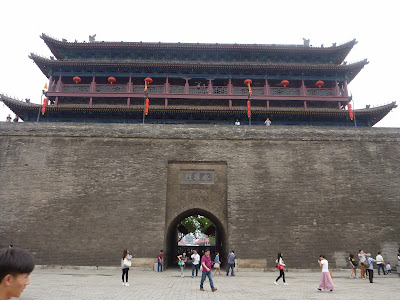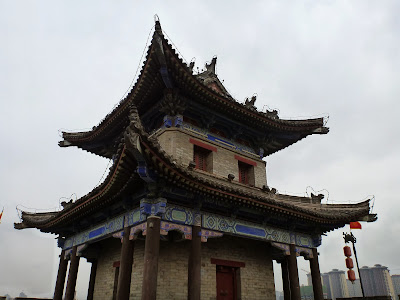Covering a rectangular block nearly a kilometer long and 3/4 of a kilometer wide, the Forbidden City was the massive imperial palace of emperors for nearly 500 years spanning the Ming and Qing Dynasties. Upon it's completion in 1420, the capital of China was moved from Nanjing (south capital) to Beijing (north capital) with the Forbidden City and Tiananmen Square sitting along the city's north-south central axis. As with most things in China, there is great symbolism in nearly every detail of the construction, colors, and layout. The walls of the Forbidden City, like portions of the Great Wall, were constructed using bricks and mortar in which major ingredients were glutinous rice and egg whites.
The night of our arrival into Beijing, we happened upon a military training of some sort meandering through a public portion of the Forbidden City. Incidentally, a half hour stroll later we happened upon the same military men performing the same ritual as they lowered and carried away the China flag between the Forbidden City and Tiananmen Square. Neat to see. Feeling confident in my assumption that this is a ritual performed twice daily, you have to be impressed with the pride displayed in practicing to give the task the precision they feel it deserves.
The following day we did the walk through the entirety of the Forbidden City. The entirety of that which is open to the public I should say. Some of it is still forbidden. I am constantly amazed will the level of detail that adorns every surface of these historic sights. I find myself spending the majority of my time inspecting like carvings or paintings for commonality that supports a hypothesis that they fast-tracked the process if you will. The evidence continues to suggest otherwise. Variance in quantities of feathers or petals, a slight extension of a foot in one painting versus the other, an imperfect pattern. All the same at a glance, all unique on closer inspection. It is maddening to me as an engineer, but I can appreciate the effort.
Like the Great Wall, once through the Forbidden City was enough for me. In one wander through, I feel as though I've seen it six or seven times. The Forbidden City is a procession of similarly ornate rectangular buildings followed by similarly massive courtyards. I considered at one point if the Chinese had discovered how to bend space. Despite walking forward in one direction for the duration of the "tour", I felt as though I continued to arrive at the same place. In front of a large, ornate, rectangular building which would be followed by a large courtyard. If you visit, don't be concerned if you miss one building or courtyard due to temporary blindness from an aversion to pollutants in the air or the distraction of a child playing behind the ropes on a centuries old lion statue, there's another big building and courtyard to come ... and another, and another, and …
Can you imagine the conversation when a meeting was held here? This is between Mr. Chang, the government official, and Mr. Chen, an employee of the Forbidden City.
Chang: Mr. Chen, good to see you. Where is the meeting today?
Chen: Good to see you too Mr. Chang, it's in the big building out back sir.
Chang: Which big building?
Chen: The rectangular one with the big courtyard behind it?
Chang: You're not helping me Mr. Chen.
Chen: You know, the fancy ornate one with the little figures at the corners?
Chang: Still not helping.
Chen: It has the beautiful carving between the stairs to the entrance.
Chang: (Irritated) They all look the same Mr. Chen.
Chen: A lot of Westerners say that. Follow me Mr. Chang, it's just a 40 minute walk.
 |
| Entrance to the Forbidden City |
 |
| Chairman Mao over the entry gate. |
 |
Military men we happened upon practicing,
we weren't sure for what at the time. |
 |
Same military men between the Forbidden City and Tiananmen
Square for the evening lowering of the flag of China. |
 |
There is a moat that surrounds the majority of the
city, passing through the city at one stage. |
 |
I have no idea what any of the following buildings are,
feel free to attempt to discern one from another. |
 |
That little fella is not suppose to be there. All buildings
deemed significant in China have two lion statues on
either side of the entryway. It has been asserted that the
one to the right as you look at the door is a male lion,
and the one to the left is female. Seeing that every
lion statue has a mane, I'm curious to know
evolution has stripped female lions of their's
in the last 600 years. |
 |
| He's actually 48. Age well here. |
 |
| The gardens behind the last building. |
 |
The hill at the north end of the Forbidden City. You can see
the entirety of the city from the top of the hill. we didn't
have the time, legs, nor will to undertake the trek. |









































































